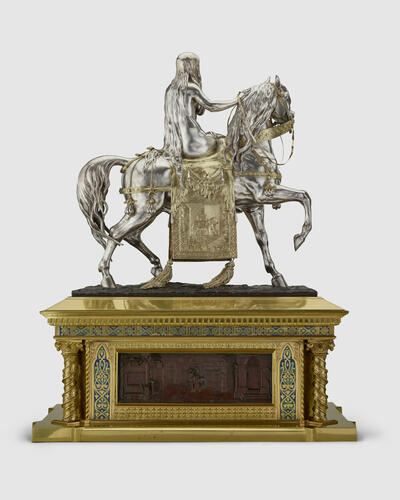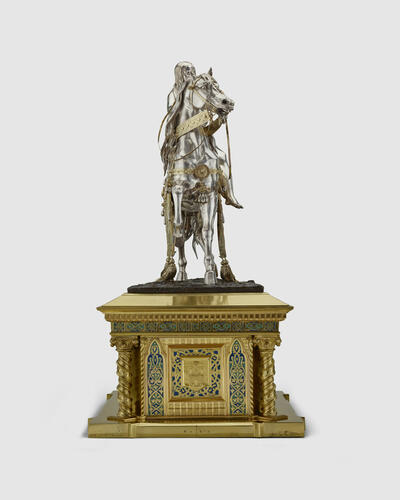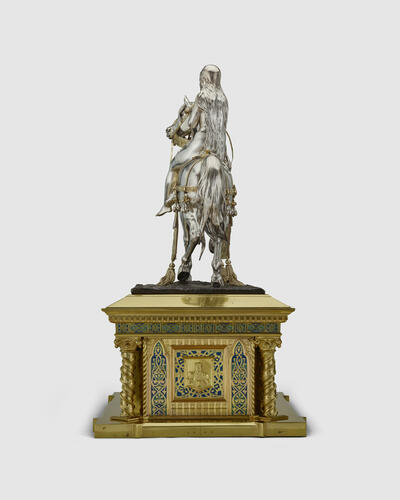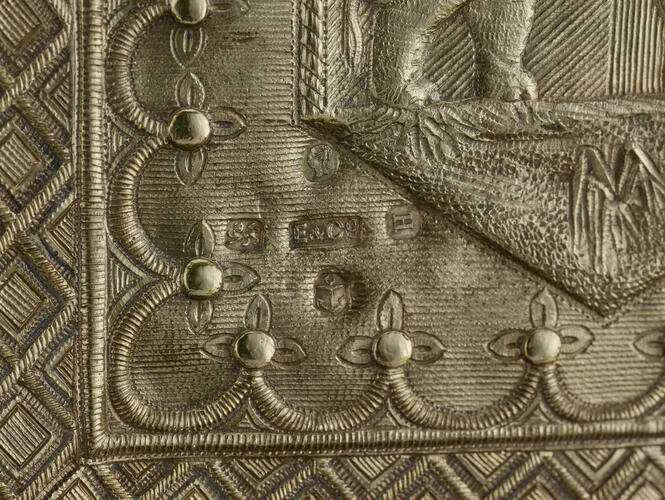-
1 of 253523 objects
Lady Godiva 1857-58
Electrotype panels on gilt brass mount with painted areas; silver horse on cast bronze slab with electrotype gilt saddle cloth | 79.4 x 62.0 x 42.5 cm (parts .a and .b together) | RCIN 1571

Emile Jeannest (1813-57)
Lady Godiva 1857-58

Emile Jeannest (1813-57)
Lady Godiva 1857-58

Emile Jeannest (1813-57)
Lady Godiva 1857-58

Emile Jeannest (1813-57)
Lady Godiva 1857-58

Emile Jeannest (1813-57)
Lady Godiva 1857-58

Emile Jeannest (1813-57)
Lady Godiva 1857-58






-
This figure of Lady Godiva was purchased by Queen Victoria and presented to Prince Albert on his birthday, 26 August 1857.
It was modelled by the French sculptor Pierre-Emile Jeannest, who worked for both Minton and Elkington. At the Great Exhibition his works for Elkingtons included a figure of Elizabeth I arriving at Kenilworth Castle which was praised by the Jury.
Jeannest was well acquainted with the French troubadour style, concerned with the medieval and the chivalric, and quickly adapted this to the English taste.
Lady Godiva was the wife of Leofric, an eleventh-century earl of Mercia, who imposed a harsh tax on the people of Coventry. Resisting Godiva's pleas on behalf of the citizens to repeal the tax, Leofric finally agreed to do so on condition that his wife parade naked through the streets of the town. This she did, her nakedness covered only by her long hair, having first issued a proclamation instructing the townspeople to remain indoors and keep their windows shuttered. From the seventeenth century onwards, Lady Godiva was celebrated in Coventry by an annual parade as ‘the people's redeemer’.
The legend proved highly popular with mid-nineteenth-century artists, perhaps inspired by Alfred Tennyson's poem ‘Godiva’ (1842):
Then she rode forth, clothed on with chastity:
The deep air listen'd round her as she rode,
And all the low wind hardly breathed for fear.
The contemporary art press also recognised that ‘almost any semi-nude subject may be turned into a Godiva’, and some of these, like the annual re-enactment processions in Coventry, tended to be controversial.
Godiva's horse, imagined by Tennyson as ‘trapt in purple blazon'd with armorial gold’, bears the arms of Coventry on the saddlecloth. Two further scenes from Lady Godiva's life were portrayed in bronze relief plaques around the base of the piece, one showing the heroine facing her husband to plead the cause of the people, the other showing the legend of Peeping Tom, who disobeyed Godiva's orders and tried to spy on her, only to be struck blind.
The base of the group was innovative for its use of champlevé enamels. Although A.W.N. Pugin and others had reintroduced this technique into church plate, this is the first recorded example of its use on a piece of secular plate by Elkingtons. It was much admired and the firm went on to produce an entire tea service using this technique for the 1862 exhibition.
Text from Victoria & Albert: Art & Love.Provenance
Purchased by Queen Victoria (payment dated 27 July 1857, £250, QV Bills, 25/816725/8167)
Given to Prince Albert by Queen Victoria, on his birthday, 26th August 1857 [Victoria & Albert: Art & Love, London, 2010, pg 462]
-
Creator(s)
(designer)(manufacturer)Acquirer(s)
-
Medium and techniques
Electrotype panels on gilt brass mount with painted areas; silver horse on cast bronze slab with electrotype gilt saddle cloth
Measurements
79.4 x 62.0 x 42.5 cm (parts .a and .b together)